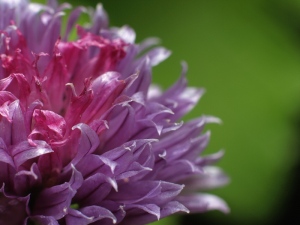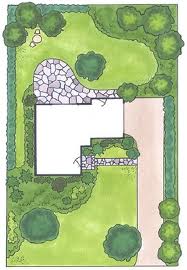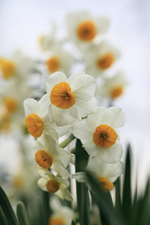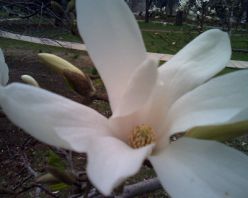Urban Garden
WOW! We love this inexpensive eco-garden idea.
This beautiful urban garden in Brazil is made from recycled plastic soda bottles. The garden is part of the Home Sweet Home project where a team visits homes and brightens up the exteriors and interiors. Who would think recycled bottles would make such a beautiful display?
(Source: enpundit.com)
Chive Flower
A great edible flower perfect for salads!
Damn you to hell, weather
great veggie garden advice for this weather!
*shakes fist at sky*.
Stupidly, stupidly, I thought a couple of weeks ago that the weather was surely getting warmer and I’d be safe to try my hand at my first bit of vegetable gardening. It was all going so well- some exciting little shoots, and then LOADS of shoots in my little plastic pot, which was living all snug and cozy on the dining room table. Then, we had some friends over for dinner so I decided to hide my pot of mud and shoots in the back garden, and what happened? Torrential rain happened. And now my poor old lettuce shoots are looking, well, pretty dead to be honest with you! And the tomatoes, after some sterling progress early doors seem to have stopped doing anything, so I’m convinced they’re on the way out now too. Not that it matters, because the good old British spring that we’re…
View original post 58 more words
Bring Contrast Into Your Garden Design
With this great weather its a great time to get out there and start your garden!
Learn some of the tips included in this article so you can make a garden that everyone can enjoy. You can have a good idea on what you need, this way you aren’t spending money on equipment you do not need, or on seeds that will not work in your environment. 
If you have a cut, be careful about exposing it to soil or gardening chemicals. Open wounds can easily get infected while gardening because you’re exposing yourself to dirt, bacteria and germs. There are now bandages available that will entirely seal off any cut they are applied over.
The approach of fall means you need to start planting autumn goodies. If you’d like to change things up a bit this season, put away your standard clay pots and plant your lettuce and kale inside of a pumpkin instead! Simply cut the pumpkin open at the top, so you can…
View original post 450 more words
Face Food
Spring is here and after a harsh cold winter need a soothing face mask to combat dry skin leaving your skin feeling super soft and invigorated! AVOCADO has super vitamins A D and E that will nourish the skin and slow down the aging process – BONUS!
Ingredients:
- 1/2 of an avocado
- 3 tablespoons of honey
- 1 egg yolk
- 1 carrot, boiled mashed and cooled
Mash avocado and carrot together until fully combined. Add the honey and the egg yolk Continue to mix all ingredients thoroughly until you have a smooth paste .
Apply to a cleansed and toned face. Apply the avocado based mixture to all areas of your face avoiding your eyes and mouth and delicate area under the eye. If any area feels a little extra dry be sure to apply a little more of the paste to that area. Let this dry for about 15 minutes. While you wait pop some cucumber slices on your eyes and relax!Wash off with warm water and immediately splash cold water on your face to close your pores.
The combination of avocado and carrot is especially good for your dry skin because of their moisturizing agents. Avocados are high in Vitamins A, D and E and are rich in unsaturated fats that will nourish your skin and slow down the aging process. Carrots consist of antioxidants and beta-carotene that will also soften and moisturize your skin. Add in honey that acts as an antibiotic and you have the perfect combination of cleansing and hydrating in your DIY face mask! It’s as simple as that. Your skin will feel silky smooth giving you an extra boost of confidence any day of the week.
Nesting Birds
Yup it’s that time of year again, you may have noticed birds flying in and out of your garden in pursuit of potential sites to nest and raise their young. Criteria that birds look for is a location that is close to a good source of food, offers protection from potential predators, is sheltered and is neither too hot, draughty or too cold. We love when birds choose our gardens and it’s always a joy to watch fledglings find their feet right before our eyes. Nest boxes can assist a birds search and, if in the right location, can be their dream property. Birdwatch Ireland has some great advice on the style of nest box to choose (depending on the species of bird you may wish to attract) and they also offer advice on choosing the best location for your nest box. It is also a good idea to provide nesting materials (the items used to build nests), as this can assist birds in conserving both energy and time. Birds love materials like:
Grass clippings or dead grass
Yarn, string or thread
Human hair or animal fur
Feathers
Cattail fluff
Moss or lichen
Pine needles
Pebbles or small rocks
Spider web silk
Straw or other plant stems
Shredded paper
Ensure that materials do not get wet and place them in a location visible to birds and where they will be safe from predators while gathering. We suggest that you drape materials close to where birds feed or you can also use empty bird feeders or mesh bags to hold the materials, just ensure that the birds can extract the materials from the holder.
It is important to think about the health and well-being of birds so ensure that materials and holders are clean and pose no health risks. It is also imperative to avoid certain materials such as; anything treated with pesticides, fertilizers or toxic materials, including pet hair that has been treated for fleas or grass clippings treated with insect repellent. Twine lengths should be between 3 to 8 inches to avoid potential strangulation. Plastic and nylon items should be completely avoided, including fishing line, as these can cause serious injuries to birds. Enjoy watching birds set up home in your garden!
Win a Designer Landscape Garden
Win a garden make-over from Greenscape Gardens. The make-over is worth €1,000 and the lucky winner will receive a tailor made design and beautifully landscaped garden. Let our expert landscapers increase the value to your home by creating this extra outdoor living space. Do you dream of having a lush lawn or you just want to impress the neighbours! For more information check out our website and read our testimonials page from our happy customers and you too could have one of our beautiful gardens by entering our competition.
To enter simply answer the following question; which yellow spring flower blossoms in March?
Send your answers by email or post along with how you heard about Greenscape Gardens. Good Luck!
The prize is based on a standard size garden of 10 metre sq. or the equivalent value of €1,000.
Competition closes 3rd March 2013.
Flowers for March
Tips to care for your March flowers
Lift and divide large clumps of hostas before the leaves get big. Slice through the root ball with a spade leaving a few shoots on each piece. Replant the sections back at their original level.
Pick off faded flowers from pansies and daffs.
Order bedding plants. Order baby fuchsias, geraniums, marguerites and other young plug plants from mail-order suppliers.
It’s also a good time to order summer-flowering bulbs, such as dahlia, gladioli and eucomis.
Hardy annuals. Sow hardy annuals such as calendula, nasturtium, lavateras and cornflowers in shallow drills or patches. They are very reliable and germinate quickly, and a good choice to keep children interested in helping you grow your flowers.
Pruning clematis. Summer-flowering clematis varieties that blossom on the current season’s growth, such as Clematis ‘Etoile Violette’, need to have last year’s growth pruned out now. Cut any tangled old stems down to a pair of new shoots near ground level as soon as possible.
Divide snowdrops. Lift and divide any congested snowdrops after flowering but while still in leaf. Carefully tease the clumps apart and replant the bulbs at the same depth they were before.
Prune honeysuckle. Honeysuckle can be pruned back now if yours has got out of hand. Prune all the shoots to about 1metre from the ground and cut out old or dead shoots. If you can see any green buds below the 1m mark then prune back to just above those. By summer the shoots will have doubled on size.
Planting begonia tubers. Plant tubers now in trays of moist compost, barely covering the top. Study the tubers carefully before planting and you will notice that they are convex on one side and concave on the other. The concave side should be uppermost in the pot. Keep them in a warm, bright position, watering when the compost dries out. Pot each one up individually when shoots are 5cm to 7.5cm (2in to 3in).
Happy Gardening!
Garden Trends 2013
With a global economic downturn and frought and stressed people are turning more to their gardens as a place of emotional connection and sharing their space with nature.They are using the space as a outdoor room where they can enjoy fragrant smells and reduce their ecological footprint.
With this in mind please see this weeks top three trends.
1. Fragrant Flowers
Well doesn’t every flower smell nice? Unfortunately not every blossom is easy on the nose. Plants that offer pleasant smelling leaves and blooms are on the increase as fragrant gardens go from a ‘nice to have’ to a must have. Top ten flowers that will have your garden sweet smelling are: Magnolia , Lilac, Fressia,Violet, Sweetpea, Rose and Gardinia.
2. Building for the bees and Butterflies
Although we all like to have beautiful looking gardens more and more of us are willing to share with natures creatures. For butterflies for instance one can attract butterflies to your garden with a wide variety of plants. With specific planting you can provide spots for sunning and laying eggs, host plants for hungry caterpillars, shallow water sources, and safe harbor when the time comes for metamorphosis. For hungry butterflies plant Phlox which the butterfly will feed off the necter, you will truly enjoy its lovely fragrance and others will admire its beautiful clusters of red, pink, lavender, salmon, or white blooms throughout the summer.
3. Edible Landscaping
A modernised update of the vegetable patch is a new trend that is catching on especially with the younger gardener. Edible landscaping is easy and more popular then even to have a good looking yard you can eat from.
If you already grow plants in your yard, it will probably be easy to incorporate vegetables, fruits, and herbs into your existing beds to make an edible landscape. Besides providing tasty produce, many edibles are gorgeous and will beautify your landscape.To design an edible landscape, first take stock of your yard. Look for lackluster plants you can replace with varieties that have edible features. Blueberries, with their spring flowers, tasty fruits, and exceptional colour, make great hedge plants. remember that you don’t need to grow edibles in straight, boring rows. Plant in graphic, pleasing patterns, leaving enough space between plants to avoid overcrowding but close enough to create a dense appearance and shade out weeds. For great performance edibles plant artichoke beet broccoli carrot hot pepper kale leek lettuce onion and radish.
























